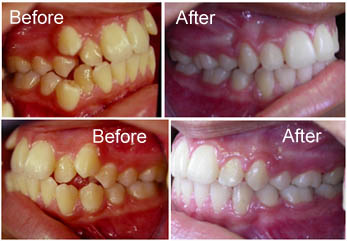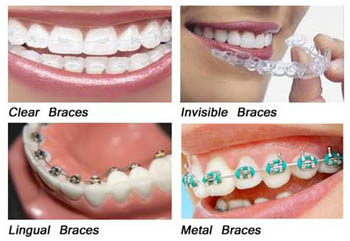KAPPEN'S ORTHODONTIC (DENTAL) CENTRE
(Centre for Advanced Orthodontics & Implants)
Vazhayil Arcade, Pala, Kottayam District, Kerala, India. Pin:686575
Tel: +91-4822-200502, +91-9846362052; Email: kocpala@gmail.com
Orthodontics, Dentofacial Orthopedics & Orthognathic Surgery
Orthodontics deals with the correction of irregularities of teeth and jaws. Orthodontic treatment leads to beautiful smiles, improved dental health and enhanced self esteem for people of all ages. Orthodontic problems can result from genetic and/or environmental factors. The case must be properly diagnosed before treatment begins and this usually involves taking photographs, radiographs (x-rays) and dental impressions.
Treatment duration varies from 3 to 24 months, depending on your goals, age and the severity of the orthodontic problem.

When to start orthodontic treatment?
Orthodontic treatment may be undertaken at any age. However, the age will influence the goals, cost, complexity, type and duration of treatment. Research has revealed that early treatment can simplify or even eliminate additional treatment for a child. We recommend that the first orthodontic evaluation take place at the age of 7 years (or earlier if specific problems are noticed).
Many treatments are available for growing children, especially when jaw irregularities are present. These treatments may also prevent some problems from getting worse. Treating children during their growing phase allows us to produce results that may not be possible when face and jaw bones have fully developed.
Types of Braces:
We do all kinds of orthodontic treatment, dentofacial orthopedics, pre and post surgical orthodontics. A classification of orthodontic appliances (braces) provided at K.O.C. are given below:

| Fixed Orthodontic Appliances | Removable Orthodontic Appliances | Dento-facial Orthopedic Appliances | Retainers |
|---|---|---|---|
| Bonded Metal Braces (labial and lingual, including Damon Braces, STB lingual system and Lingual Matrix) | Invisible Aligners (Clear Path, 3D Ortholine, Clear Step, Others) | Head Gears | Fixed Retainers |
| Bonded Non Metal Braces (Ceramic) | Acrylic Removable Appliances | Reverse Head Gears (Face Mask) | Removable Acrylic Retainers |
| Cemented Appliances | Functional Appliances | Chin Cup | Removable Invisible Retainers |
| TAD (Temporary Anchorage Devices/Micro Implants) | Rapid Maxillary Expansion |
Dentofacial orthopedics
Dentofacial orthopedics deals with the modification of growth and development of jaws in growing children.
Orthognathic Surgery
Orthognathic surgery involves the surgical correction of the abnormalities of the facial bones, specifically the jaws. These abnormalities cause difficulty in chewing, talking and sleeping. Orthognathic surgery in conjunction with orthodontic treatment, improves the overall appearance of the face.
Temporary Anchorage Device (TAD)
TAD is a miniature screw that is placed in the jaw to serve as an anchor for moving specific teeth in a very controlled way. They can eliminate or reduce the use of headgears, springs and elastics and promote faster and more efficient treatment than conventional appliances.
The TAD is made of Titanium and is placed under topical and/or local anesthesia. Insertion or removal of TAD is almost painless.
Frequently Asked Questions:
How do I know if my child is in need of orthodontic treatment?
There are many problems that may be present although the front teeth look good. On the other hand there are some problems that appear complex, but will resolve with time. We recommend that your child come to us for a consultation by the age of 7.
Am I too old for braces?
No, you can undergo treatment at any age provided your teeth and their supporting structures are healthy.
Is it painful?
Braces might make your teeth sore for a few days. This can be relieved by taking some pain killers. At K.O.C, the combination of top quality braces and very advanced wires make the treatment quite comfortable. We use the latest braces and the highest quality materials for maximum comfort and decreased treatment time.
What if I have several missing teeth?
Yes, you can have braces. With the use of TAD, previously impossible to treat cases can be treated.
What is Phase I and Phase II treatment?
Phase I or Interceptive Treatment usually starts in the early mixed dentition. This stage in development is usually about the age of 7 to 8 years. Phase I treatment aims at intercepting a moderate or severe orthodontic problem early in order to reduce or eliminate it. These problems include jaw discrepancies, crossbites and crowding. Phase I treatment utilizes the early growth spurt and converts a difficult orthodontic problem into an easier one. This may help to reduce the need for extractions or surgery.
Phase II treatment is most commonly done around the age of 12 or 13 when most of the permanent teeth are erupted. The aim is to get an ideal bite with most of the permanent teeth.
Can we reduce the orthodontic treatment duration?
New protocols, called Accelerated Orthodontics involving periodontal surgery may reduce treatment time.
What are lingual braces?
Lingual braces are fixed on the inner side of teeth. It is more expensive than regular braces.